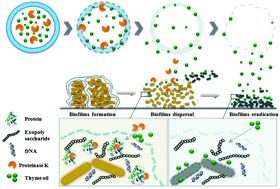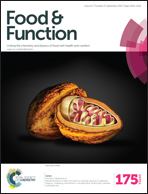Co-loaded proteinase K/thyme oil liposomes for inactivation of Escherichia coli O157:H7 biofilms on cucumber
Abstract
E. coli O157:H7 is a bacterium frequently found on vegetable surfaces, such as cucumber, that can pose a significant threat to consumers. In the present work, proteinase K (PK) and thyme oil (TO) were used to inactivate E. coli O157:H7 biofilms. Both PK and TO were encapsulated in liposomes to improve their chemical stability and to allow for a controlled release. The optimal PK/TO-loaded liposomes (particle size of 170.4 nm, polydispersity index of 0.309, zeta potential of −29.8 mV and entrapment efficiency of 33.2%) were engineered. The antibacterial activities of the PK/TO liposomes against E. coli O157:H7 biofilms in vitro and on the cucumber were observed. Compared to free PK, free TO, and free PK/TO and TO liposome treatments, PK/TO-liposomes exhibited a higher antibiofilm activity and longer action duration. Specifically, the counts of viable E. coli O157:H7 on cucumbers were reduced by 1.23, 2.32 and 2.44 Logs after treatment with 400 mg mL−1 of PK/TO liposomes for 3 d, at 5, 15 and 25 °C, respectively. Colorimetric analysis and sensory tests showed that the PK/TO-liposome treatment had almost no impact on food quality after 1 d.



 Please wait while we load your content...
Please wait while we load your content...